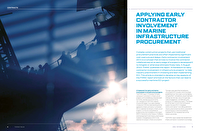A framework for early contractor involvement in infrastructure projects
The PIANC report “A framework for early contractor involvement in infrastructure projects” and is available as a free download for PIANC members (and 215 EUR for non-members) on the PIANC website. At some 183 pages, it provides a detailed introduction into the understanding and the application of early contractor involvement (ECI) in waterborne transport infrastructure projects. It is the only comprehensive guidance document available on the subject of ECI in the construction industry. It offers a practical approach to all industry practitioners to assist in the application of ECI in the waterborne transport infrastructure sector.
The report also identifies the hallmarks of successful ECI process, which have been established over many years, such as dealing with good faith, transparency, equal treatment of all parties, fairness, clarity through clear rules of engagement, confidentiality and protection of intellectual property. The stated aim of the report is to further promote and support the use of ECI in the global construction sector. It provides guidance to industry practitioners so clients, consultants and contractors in how to successfully implement ECI for the betterment of the industry as a whole.
The PIANC report states that the definition of early contractor involvement is a strategy initiated by infrastructure owners (clients) towards main contractors and optionally expanded to consultants, stakeholders and subcontractors. The purpose being to optimise values in project delivery and objectives, through their participation and knowledge sharing in stages of project planning and design prior to project execution.
When drafting the report, the authors noted that there was no single dominant concept or approach to ECI. Diverse regions and countries appear to deal with ECI differently. The common denominator identified was that ECI is a strategy initiated by infrastructure owners (clients) towards main contractors and optionally expanded to consultants, stakeholders and subcontractors. The purpose being to optimise values in project delivery and objectives, through their participation and knowledge sharing in stages of project planning and design prior to project execution.
It is important to note that while the principles of early contractorinvolvement may be universal, the specific practices and methods for implementing ECI can vary greatly depending on the region and industry. To ensure success, clients and contractors should take into account the best practices and lessons learned from previous ECI projects in their specific region and apply them to their current project, while also considering the unique local conditions and challenges. This can include factors, such as cultural differences, regulatory requirements and market conditions such as the availability of resources. By taking a localised approach to ECI, clients and contractors can tailor their project to the specific needs and constraints of their region, leading to a more efficient and successful outcome.
A shift to more collaborative contracting
The “business as usual” model of procurement is usually driven on a pure transactional basis by the client seeking the lowest price from tenderers for their project – using either a completed design or for tenderers to price the client’s requirements on a design and construct basis. With design and construct, using a traditional tender process there was little scope for innovation and cost savings as usually the client’s requirements were fixed. Contractors would be reluctant to propose valuable innovative alternatives as there is always a threat that the tender could be cancelled and re-tendered on the basis of their own alternative, now exposed to the competition.
As Jon Davies, CEO Australian Constructors Association stated in a social media post (LinkedIn, January 2023): “There is significant wastage of skilled resources through inefficient tender processes, but the bigger problem is the myopic focus on selecting the lowest price at the tender box to the detriment of all else. The practice of accepting the lowest bid at the tender box is a completely false economy and is the direct cause of the adversarial contracting environment in which we now find ourselves.”
The traditional procurement approach invariably leads to cost and time overruns during project execution. The causes of these overruns have been studied extensively (Arcadis, 2022 Global Construction Disputes Report, Bent Flyvbjergand Gardner, 2023).
A detailed study by Flyvbjerg and Gardner of some 16,000 major projects from large buildings to bridges, dams, power stations, rockets, railroads, information technology systems and even the Olympic Games, revealed a massive project management problem. Only 0.5% were completed on time and on budget, and produced the expected benefits. In other words, 99.5% of large projects failed to deliver as promised.
The highlighted events and challenges mentioned in Figure 1 are being felt postpandemic and construction industry parties are looking to alternatives to the business as usual approach for potential projects.

















